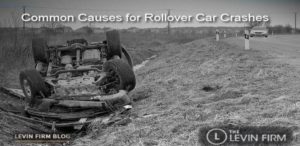 Rollovers are among the most dangerous types of car accidents. According to the National Highway Traffic Safety Administration, they only account for 3 percent of all accidents, yet cause approximately 33 percent of all occupant deaths resulting from car crashes.
Rollovers are among the most dangerous types of car accidents. According to the National Highway Traffic Safety Administration, they only account for 3 percent of all accidents, yet cause approximately 33 percent of all occupant deaths resulting from car crashes.
Car accidents, in general, claim 32,000 lives annually and injure 2 million people, according to the U.S. Centers for Disease Control and Prevention. If you or someone you know has been injured in a car accident, it is important to seek the help of a car accident lawyer who can assist with legal matters and ensure that you receive the compensation you deserve.
Most Common Causes of Rollovers
What causes rollovers? Once you know, you can take steps to minimize the chance of a rollover occurring in your vehicle.
Speeding
Rollovers occur when the vehicle tips and becomes unbalanced. This can happen if the car goes too fast for conditions, such as on a curve or highway exit. A rollover caused by speeding is even more likely to happen in a vehicle with a high center of gravity, such as an SUV.
Weather also factors into speeding as a common cause of rollovers. Pavement slick from rain can make a speeding car even more likely to tip.
Drinking and Driving
Alcohol impairs driving behaviors, such as judgment, reaction time, and reflexes. An alcohol-impaired driver may cause a rollover by speeding or poor judgment, such as driving on uneven pavement or on/off the shoulder. The latter can unbalance the center of gravity and cause a rollover.
Alcohol impairment causes roughly one-third of traffic fatalities in the United States, according to the CDC.
Drowsy Driving
Like alcohol consumption, drowsy driving impairs driving by impairing judgment, reaction times, and reflexes. According to the CDC, roughly 50,000 injuries and 800 deaths annually stem from drowsy driving.
Driver Behavior
Driver behavior can significantly contribute to rollovers, according to Consumer Reports. Quick and sudden changes in direction, for example, can unbalance the center of gravity as much as speeding on a curve, as when a driver turns one way and then quickly turns another to correct the course. Drivers who drive partly on the pavement and partly on the shoulder can also precipitate a rollover, as this unbalances the vehicle.
Worn Tires
Worn tires do not grip and hold the road as well as properly maintained tires do. The failure to grip and hold sufficiently can lead to rollovers, especially in a speeding or unbalanced vehicle.
Chronically overinflated and underinflated tires will contribute to the wear and tire on your tires. Keeping tires in good condition and properly inflated can protect against accidents such as rollovers.
Overloading the Car
Remember, all rollovers stem from an unbalance in the car and a shift in the center of gravity. Overloading a car can have this effect. An SUV with biking gear or heavy luggage on the top, for example, may lack the stability to remain upright, especially when speeding and on curves.
Always know how much weight your car can carry. Generally, place heavy objects toward the bottom rather than the top to avoid imbalance.
Tipping
Many rollovers as much as 95 percent involve tipping. Tipping can occur when your car hits an object, such as a curb, pothole, slope, or even debris on the road, that imbalances tip the car.
Rural Roads
An estimated 75 percent of rollovers occur on rural roads rather than city streets or freeways. Rural roads tend to lack barriers, so drivers may drive partially off the pavement and unbalance the car.
Can I Do Anything Else to Protect My Family From Rollovers?
While you can follow safe driving practices to avoid rollovers, you can protect your passengers in case a rollover occurs.
Seatbelts
Always make passengers wear seatbelts in the car. If a rollover or partial rollover occurs, seatbelts protect occupants from severe injuries and death.
Safety Standards
Car manufacturers and government regulators are keenly interested in design that makes rollovers less likely and protects consumers in them.
Consumer Reports points out that newer model cars are more likely to have electronic stability control, which can help to prevent rollovers. Increasingly common side airbags can increase safety in rollovers.
Defensive Driving
Rollovers are not only dangerous only if you are in one; they are dangerous to other vehicles. A vehicle rolling over can careen across lanes or hit adjacent vehicles.
Always observe traffic closely. Do not follow other cars too closely, so you have plenty of time to stop. Slow down if you see a driver swerving or driving erratically; you want to avoid these early stages of a rollover or other accident.
What Should I Do After a Rollover?
After a rollover:
Find a Safe Place
If the rollover places your vehicle in traffic or a dangerous place (such as precariously on a downward slope), do your best to find a safe place. You want to stay away from moving traffic and out of a dangerous car.
Note, however, that rollovers can cause serious injuries. If the accident seriously injured you, do not try to move yourself or your vehicle. Call for emergency assistance.
Call Law Enforcement
After a rollover, call law enforcement (or 911 if you or anyone in the vehicle suffers severe injuries). If emergency responders call an ambulance for you, go to the emergency room.
If you can stay at the scene, get a copy of the police report. Law enforcement will file an initial report about the accident, including the officer’s opinion of the cause. Police reports contain important evidence.
Get Contact Information
While some rollovers are single-car accidents, others can involve multiple vehicles. If your rollover involved another driver, get appropriate contact information from them, such as their car insurance information, name, and e-mail address.
Obtain eyewitness contact information as well if you are comfortable doing so. If the rollover stemmed from someone’s negligence, you may need to pursue financial compensation from them. If so, you will need evidence about what or who caused the accident. Eyewitnesses who saw it can help.
Take Pictures of the Scene
If you have a smartphone with you, take pictures of the accident scene and your vehicle. Pictures provide excellent evidence of what occurred.
Obtain Medical Attention
Everyone in a rollover should seek medical attention as soon as possible. (After a serious injury, medical attention should come first on the list. Your car accident lawyer can obtain other evidence, such as the police report and witness contact information, later.)
Do not rely on your own sense of whether you suffered injuries or not or their severity. Some of the most serious injuries may not seem significant. Broken ribs may feel like a severe bruise. But a broken rib can puncture your lung and that can prove fatal.
See a doctor or visit the emergency room as soon as possible. Explain what happened. Follow any advice they give to ensure your recovery.
Victims should take care to keep all records of medical treatment, including dates of visits and recommended treatments.
Take pictures of your injuries for an evidential record.
What if Someone Else Caused the Rollover?
If a rollover occurs because of the negligence of another party, or a rolled-over vehicle harmed you, you may recover compensation.
Negligence, in legal terms, means a failure to render the duty of care. A driver, for instance, needs to drive safely and follow the law. A speeding driver, or one impaired by alcohol, breached the duty of care. Negligent parties are liable or financially responsible for injuries and harm they cause.
While other drivers may exhibit negligence, they are not the only potentially negligent parties in a rollover. Rollovers can also stem from poorly manufactured or improperly repaired cars. If a manufacturer produces defective cars or parts, you can hold them negligent. If a repair shop repairs a car or a specific part improperly, you can hold them negligent.
What Damages Can I Seek From Negligent Parties?
Lawyers and courts call for financial compensation for injuries and damages.
The damages you can seek depend on your state of residence, whether or not it is a no-fault state, and the nature of your injuries.
No-fault means that drivers generally must turn to their own insurance to cover injuries and harm from accidents, regardless of fault.
Fault states, on the other hand, allow victims of negligence to seek compensation from the at-fault party through insurance or bringing a lawsuit to civil court.
Some states allow drivers to choose whether they want fault or no-fault insurance. Many no-fault states, in addition, allow severely injured victims to step outside of the no-fault system. Broken bones often qualify as severe injuries.
If you can pursue an insurance claim or bring a suit, you can generally seek compensation for:
- Medical bills, for emergency transport and car, hospitalization, doctor’s visits, prescription medication, tests, physical therapy, and more.
- Lost income from work, if the accident and treatment cause you to lose income from work.
- Pain and suffering, for physical, emotional, and psychosocial pain related to the accident and injuries.
- Property damage, if your property is damaged due to the negligence of another party.
What if My Loved One Dies?
What if a loved one dies in a rollover or due to injuries caused by negligence? In that case, the suit is termed a wrongful death.
After a wrongful death, the deceased’s survivors can usually seek damages for funeral and burial expenses, medical expenses before the death, and lost income that the deceased would have received had they lived.
Non-economic damages include loss of care and companionship.
What if I Do Not Know What Caused the Accident?

Consult a personal injury lawyer in Philadelphia. Rollovers can present legal complications, especially if caused by multiple factors or manufacturing or repair defects. Car rollover attorneys often work with investigators who seek out the causes of accidents.
Lawyers can also see if surveillance footage shows the accident and can shed light on it. Investigators can look for potential eyewitnesses and talk to them.
Lawyers also can work with forensic specialists who can examine the accident scene and even recreate it to find out why it occurred and who caused it.
If you need further information, contact a car accident attorney.